Mcdougal Littell Preparing for the Istep Language Arts Test Elementary School
Welcome to our FTCE Unproblematic G-vi practice test and prep folio. On this folio, we outline the domains and primal concepts for the FTCE Unproblematic K-6 test. It is a complimentary resource we provide so you can meet how prepared you lot are to take the official exam.
While this costless guide outlines the competencies and domains constitute on the exam, our paid FTCE Elementary One thousand-half dozen study guide covers EVERY concept you lot need to know and is set up to ensure your success! Our online FTCE Uncomplicated Thou-6 study guide provides test-aligned study material using interactive aids, videos, flash cards, quizzes and practice tests.
Volition I pass using this free article? Will I pass using your paid study guide?
If y'all use this guide and research the fundamental concepts on the FTCE Elementary Chiliad-vi test on your own, it's possible y'all will pass, but why take that chance? With our paid study guide, nosotros guarantee y'all will pass.
→ Subscribe Now: FTCE Unproblematic Ed K-half-dozen
Not prepare to start studying notwithstanding? That'southward OK. Proceed reading, and when you're ready take our free FTCE practice tests.
In this article, nosotros will cover:
- FTCE Elementary Education K-6 Test Data
- FTCE Elementary Education M-vi FAQs
- FTCE Elementary K-6 Top Tips
- FTCE G-6 Language Arts and Reading Overview
- FTCE Elementary Ed K-6 Social Science Overview
- FTCE Thou-six Science Overview
- FTCE K-6 Mathematics Overview
FTCE Simple Education K-six Test Data
The FTCE Elementary Education K-6 (060) is a required exam for anyone seeking teacher certification in grades M-6 in Florida. The test covers content and content teaching.
There are four subtests:
- Language Arts and Reading
- Social Scientific discipline
- Science
- Mathematics
If this is your first time to take the exam, you must register for the full exam (all four subtests). After a first effort, y'all can register for any combination of subtests. You have to laissez passer all subtests to earn a passing score for the test.
The exam is a reckoner-based test, merely don't worry, you lot just need basic computer skills. If yous fabricated it to this point in your education and career, you have null to worry about.
Hither is the subtest format and fourth dimension allocation breakdown:
| Subtest | Questions (Multiple-Pick) | Time (Minutes) |
|---|---|---|
| Language Arts and Reading (601) | sixty | 65 |
| Social Science (602) | 55 | 65 |
| Science (603) | 55 | 70 |
| Mathematics (604) | xl | 70 |
Cost: $150 for the total exam (first attempt)
Retake: $37.50 (1 subtest); $75 (two subtests); $112.50 (three subtests); $150 (four subtests)
Location: Tests are by appointment only, year-circular.
What to Bring: You demand to bring two valid, unexpired forms of identification in English language.
Number of Attempts: There are no limits on how many times yous can have the test before you laissez passer; however, y'all do have to wait 31 days betwixt testing attempts.
Scoring: You need to score at least 200 points per subtest. All four subtests must be passed. When you end taking the examination, y'all will immediately go an unofficial laissez passer/non-pass result (unless they are experiencing score report delays). Y'all can expect your official FTCE score inside iv weeks.
Register for the FTCE Elementary Education Yard-6 exam hither.
FTCE Unproblematic Instruction K-6 FAQs
- What FTCE test practice I demand to have?
-
The Bureau of Educator Certification (BEC) determines your testing requirements subsequently you apply for certification. Click here for more info.
- How long will the FTCE Elementary Didactics K-vi test accept me?
-
The total exam itself is 4 and a one-half hours but expect to be at the testing site longer. It takes time to become checked in and get started. Plan to go far at least thirty minutes before your appointment time.
- Practise I get a break during the FTCE Elementary Education Thousand-6 test?
-
Yes. If yous are taking three or more subtests, you will become a scheduled xv-minute break. This break does non count equally testing fourth dimension. Withal, if you are taking 1 or two subtests, unscheduled breaks count towards your testing time.
- What tin can I await when I arrive at the testing site to take the FTCE Elementary Education G-6 test?
-
When you go there, wait to accept your identification checked, your photograph taken, your palm scanned, your eyeglasses checked, and to place your belongings in secure storage. You lot will be given an erasable notepad and pen. Before starting the examination, yous'll have to complete a curt tutorial and sign an agreement.
- Can I see what answers I got wrong on the FTCE Elementary Education K-half-dozen test?
-
If you do not pass a subtest, you may be eligible to annals for a score verification session where you can review incorrectly answered multiple-selection questions. At this time, you could also submit scoring challenges if you feel there is an error.
- Is the FTCE Unproblematic Education K-6 test hard?
-
It is challenging.
In Spring 2018 the passing rates was 62% across all subtests.
- How practise I laissez passer the FTCE Unproblematic Didactics Chiliad-6 test?
-
To pass the FTCE Elementary Education K-6 test, yous must first empathize what is on the examination and what you volition be expected to know. The all-time mode is to review the 240Tutoring test breakdown materials and do questions. In one case y'all identify areas of weakness, you lot tin can begin targeting those areas with instructional content and practice questions.
FTCE Grand-6 Study Tips
- Make certain to answer every question (fifty-fifty if you lot gauge)
- Know how much time you have left
- Eliminate incorrect answers outset
- Work through practice questions so yous know what to expect
- Written report quality, trusted sources (like 240Tutoring)
FTCE K-half-dozen English Overview
Overview
You will take 65 minutes to complete 60 multiple-choice questions.
The FTCE Uncomplicated Teaching K-6 Language Arts and Reading subtest tin be neatly divided into five different sections. Those five sections are:
- Reading Process
- Literary Assay and Genres
- Linguistic communication and the Writing Process
- Literacy Educational activity and Assessment
- Communication and Media Literacy
Reading Process

This department involves simply understanding how students acquire to read and so taking that cognition and teaching students how to read.
Reading process questions brand up about 29% of the Linguistic communication Arts and Reading subtest.
At that place are three large concepts you definitely have to know to become these questions correct:
- Emergent Literacy
- Text Assay
- Educational activity Strategies
Emergent literacyis basically what a student understands nearly reading and writingbeforehe/she can read and write words. It's really the first step in the literacy procedure. Literacy ways the ability to read and write.
You need to know terms like phonological awareness, concepts of print, and decoding. And you lot need to know the steps in both oral and written language evolution.
Text analysisincludes knowing the master parts of comprehension. Comprehension means understanding something. And so, basically, students demand to understand what they read.
Castor up on terms like principal idea, supporting details, author's purpose, indicate of view, inference, and conclusion. As well, be able to decide the all-time means to explicate and use charts, tables, pictures, etc. in texts to help students understand the book improve.
And the terminal is teaching strategies. You need to know the all-time practices for education decoding skills, fluency development, vocabulary beyond content, reading comprehension, and critical thinking skills.
Be very sure y'all know the components of fluency, too (accuracy, automaticity, rate, and prosody). At that place are lots of ways to teach these things, but some ways are considered "best."
Now, those are the three wide concepts to exist familiar with.
Specific Concepts
Right now, I'1000 going to requite you three specific concepts to be familiar with because they volition most likely appear on the test.
Phonological Awareness
The first specific concept is phonological awareness. This is simply the power to hear and distinguish between the smallest unit of measurement of sound. And the smallest unit of sound is otherwise known as a phoneme. Developing phonemic awareness among students is actually going to assistance them equally they acquire to sound out words.
Now, in that location are a few best practices for teaching phonemic awareness, then yous need to make certain that you research and understand what those all-time practices are.
Concepts of Print
The second specific concept is concepts of impress. This only means basic knowledge virtually text. Even more simply, does a student know how a volume works? It includes reading from left to correct, reading from meridian to bottom, knowing that the letters brand words that ship a bulletin, using "return sweep" (move from one line to the next) and that every book has a front, back, and author.
There are several assessments out there that examination a pupil's concept of print.
Y'all demand to know what it is, why it'southward of import, how to assess it, and how to teach it.
Fluency
And finally, y'all need to know what fluency is and what the chief parts of it are. In really simple terms, fluency is beingness able to read words correctly and quickly and not sound similar a robot. The large parts of fluency are accuracy, automaticity, rate, and prosody. You need to know what these words mean.
Accuracy is reading the words correctly.
Automaticity is knowing the words right away. You lot don't take to sound anything out or remember virtually it. You lot just know information technology.
Rate is basically how many words a pupil can read per minute. But the kicker here is that a student needs to comprehend what they read. So, if they read way too fast and don't empathise what they simply read, that'south no good. They demand to read at a rate that too allows them to understand what they read.
Prosody is a fancy word for expression. Basically, you don't want to audio like a robot. You desire to read in phrases, not word by word.
Literary Analysis and Genres
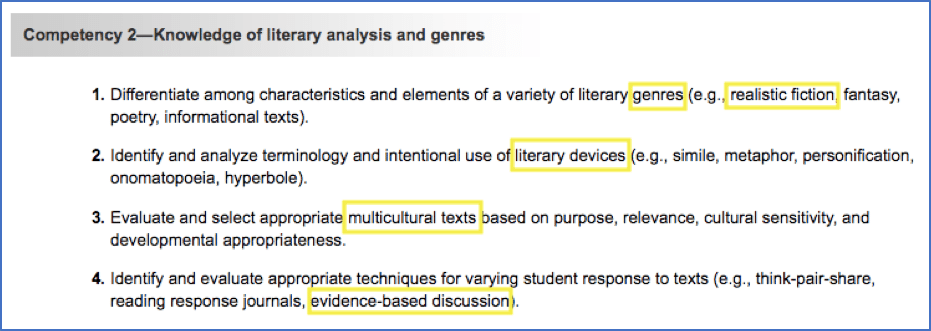
This department includes knowing about the unlike kinds of books and beingness able to call up almost them and respond to them in a higher-level fashion.
Literary assay and genres questions make up well-nigh sixteen% of the Language Arts and Reading subtest.
In that location are iii big concepts y'all definitely have to know to get these questions correct:
- Types of Genres
- Literary Devices
- Pedagogy Strategies
Types of genres means knowing the different kinds of books out there. There are realistic fiction books, fantasy books, verse, informational texts, etc. You need to know the different kinds of books and what makes them dissimilar from the residual (their features).
Literary devices are things author'southward utilize to make their writing special. These include things like similes, metaphors, personification, onomatopoeia, hyperbole, etc. You need to know what these words mean and be able to detect examples of them.
And the concluding is pedagogy strategies. Yous need to know the all-time practices for choosing books for instruction and how to teach students to respond to books. This includes different strategies like think-pair-share, reading response journals, and testify-based word.
Be sure to know what multicultural texts are and why they are important to employ.
Those are the three big concepts to know and sympathize.
Specific Concepts
Now, hither are three specific concepts to be familiar with because they will almost likely announced on the test.
Realistic Fiction
The first specific concept is knowing what realistic fiction is. Realistic fiction includes stories that could actually happen in existent life but didn't. Remember Because of Winn-Dixie and Shiloh. The setting, characters, and plot could happen or could have already happened. In that location isn't anything magical or make-believe about them.
Evidence-Based Give-and-take
The second specific concept to know is what show-based discussion is. Basically, students must apply evidence, or proof, from a book to justify their answers or comments. If they can't prove it with clues from the volume, it probably isn't right. Just like a person can't be prosecuted for a law-breaking without show, a student can't depict a conclusion from a book without bear witness. Evidence is central.
So, you need to know how to facilitate, or guide, students to have evidence-based discussions nearly books.
Multicultural Texts
And the last specific concept to know is what multicultural texts are and why they are of import to use.
Multicultural texts are books nigh underrepresented groups of people. These groups aren't a function of the "mainstream" in terms of race, ethnicity, religion, language, etc. It is important for students to be exposed to multicultural books so that they proceeds a basic agreement of the world and the people in it. These books can assist them empathize their own culture and the civilisation of others.
Every bit a instructor, it will be your job to apply multicultural books for instruction that are appropriate, sensitive, and relevant. You don't want to utilize a book that is offensive or outdated.
And so, think well-nigh different ways to utilize multicultural books in the classroom.
Language and the Writing Process
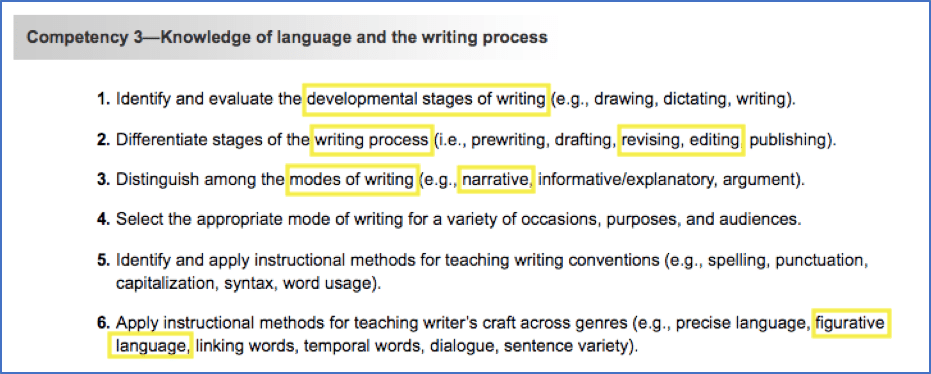
This section involves knowing how students develop in writing, what the writing process is, and how you tin effectively teach students to write.
Language and the writing procedure questions brand upwards nearly 16% of the Language Arts and Reading subtest.
There are four large concepts you definitely have to know to get these questions right:
- Developmental Stages of Writing
- Writing Process
- Modes of Writing
- Instruction Strategies
The commencement big concept you have to know are the developmental stages of writing. The stages of writing development will go from when a child is first learning to write (scribbling) to when they're starting to use grammar and the finer points of grammar to make their point.
The stages of writing development are:
- Scribbling
- Mock letters
- Letter formation
- Discussion writing
- Sentence construction
- Spelling, punctuation, and grammatical expression
So, make sure you're familiar with each phase of writing development, the characteristics, what students demand to acquire, and what kind of instructional activities they need to progress on to the next stage.
The writing procedure is specifically referring to what needs to happen to become from a non completed writing assignment to a completed writing assignment.
The stages of the writing process are:
- Prewriting
- Drafting
- Revising
- Editing
- Publishing
Make sure you know the purposes of each phase and how students should engage in each stage.
So, what should students be doing during the prewriting stage that differs than in the writing stage? And what should students be doing during the revision phase that's different than in the editing stage?
All of this is almost guaranteed to come up on the test.
Modes of writing describes the different ways students tin write.
The different modes of writing include:
- Narratives
- Informative/Explanatory
- Statement
Yous demand to know the difference between the modes and how to select the most advisable mode of writing for a multifariousness of occasions, purposes, and audiences.
And the last big concept is teaching strategies. Yous need to know the best practices for teaching writing conventions.
Writing conventions include:
- Spelling
- Punctuation
- Capitalization
- Syntax
- Word usage
You likewise need to know how to teach the craft of writing. This ways that you can teach students to effectively use precise language, figurative language, linking words, temporal words, dialogue, and judgement variety.
Know those terms and the all-time practices for teaching them.
Those are the four large concepts to know and understand.
Specific Concepts
Now, hither are three specific concepts to be familiar with because they will about likely announced on the test.
Revising versus Editing
The kickoff specific concept to know is the difference between revising and editing. They are non the aforementioned thing!
Revising means you change a few words or sentences to brand your writing better. You may articulate upward any confusing parts or add more details. The content of your writing changes.
Editing means yous fix errors in your writing like spelling, capitalization, punctuation, etc. Maybe you forgot to capitalize someone's name or put a period at the end of a sentence. The content of your writing does non change.
And so, be sure you know the departure between revising and editing.
Narrative Writing
The second specific concept to know is what narrative writing is. A narrative is a story (usually about a personal feel). The reader typically learns a lesson at the end of the story.
Most narratives include a theme, characters, setting, and plot. The plot is the primary events of the story.
After knowing what a narrative is, you lot need to know how to use the writing procedure to teach students how to write a narrative. This includes prewriting, drafting, revising, editing, and publishing.
So, know what a narrative is and how to teach students how to write one.
Figurative Linguistic communication
And the last specific concept is figurative language. Figurative language is when you apply words or phrases in a unlike mode than normal.
Figurative language includes:
- Alliteration
- Hyperbole
- Metaphor
- Onomatopoeia
- Personification
- Simile
There are more kinds of figurative language, but these are the ones most probable to come up up on the exam. Know these terms and be able to identify examples of each.
Literacy Education and Assessment
This section involves knowing how students develop in writing, what the writing process is, and how you can effectively teach students to write.
This department includes knowing how to teach students to read and write, knowing how to monitor and assess students' reading and writing skills, and knowing how to analyze those assessments to see what you need to do next.
Literacy instruction and assessment questions make up about 23% of the Language Arts and Reading subtest.
There are three big concepts you definitely have to know to get these questions correct:
- Teaching Strategies
- Literacy Assessment
- Information Analysis
The first big concept y'all need to know is teaching strategies for literacy. Basically, you need to know different ways to teach students to read and write. At that place are a few best practices for instruction that you demand to be familiar with: literature circles, small groups, workshops, reading centers, and multiage groups.
Know what those are and how to implement each in your classroom.
The adjacent big concept is literacy assessment. This means that you should exist able to track pupil progress in unlike ways, sympathise what the data is saying, and make plans to help students who only aren't getting it.
Now, within each of those iii things, in that location are several things you need to know because they will more than likely pop up on the test.
Here are some different kinds of assessments:
- Norm-referenced
- Criterion-referenced
- Diagnostic
- Curriculum-based
There are more, but these are the ones that you demand to know for the test. Be sure to know what they are, when you should use them, and what makes them different from the rest.
There are also different ways to assess how students are doing:
- Breezy reading inventories
- Fluency checks
- Rubrics
- Story retelling
- Portfolios
Know what these are and the best times to use them.
The last big concept to know is information analysis. Basically, you need to exist able to use all that cess info and make action plans to help students succeed in reading and writing. This information should help you plan your education. It should likewise guide your talks with students and their parents.
And so, know how to look at student data and use that data to drive your decisions in the classroom.
Those are the three large concepts to know.
Specific Concepts
Now, here are iii specific concepts to know.
Norm-Referenced versus Criterion-Referenced
A norm-referenced test compares a student'due south progress to other students.
A criterion-referenced test compares a student's progress to a set of standards. It doesn't consider how other students did.
Now, these are two very different types of assessments with dissimilar goals and knowing when and where to use each cess is going to come up upwardly on the test.
Intervention
This is a set of steps that a teacher takes to help a student better reading or writing skills. If y'all discover a student is struggling, this is what y'all do to help them.
Don't forget that you lot have to document everything. If y'all don't write it down, information technology didn't happen. Good documentation tin can actually help both a educatee and the teacher.
Multiage Groups
Multiage grouping ways putting students of varying ages together in the aforementioned classroom or group. The idea is that these students can learn from each other.
You should know how multiage groups can help students learn to read and write.
Communication and Media Literacy
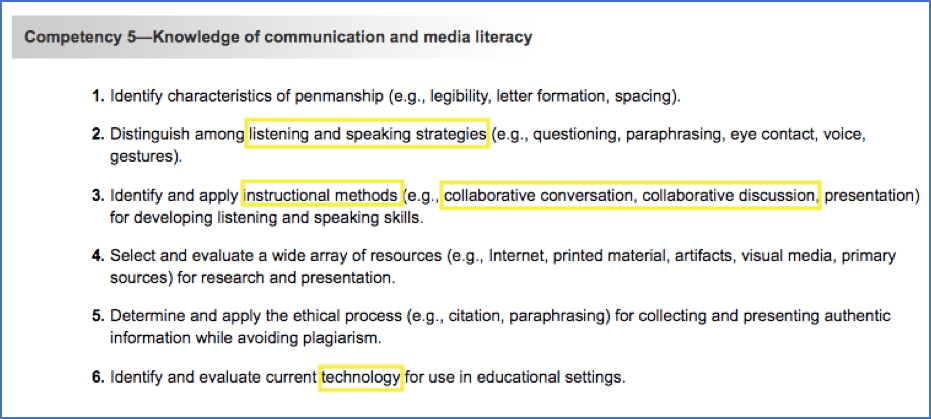
This department involves knowing dissimilar ways to communicate with students and how to employ technology appropriately in the classroom.
Communication and media literacy questions make upwards most 16% of the Language Arts and Reading subtest.
At that place are 3 big concepts you lot definitely have to know to get these questions correct:
- Communication techniques
- Education strategies
- Applied science
The first big concept to know is communication techniques. In that location are different ways to communicate with students. This includes:
- Questioning
- Paraphrasing
- Middle contact
- Voice
- Gestures
Of course, there are way more. But these are the peak ones to know for the test. Know what they are and how you tin can use them to communicate with students.
Another big concept is teaching strategies for developing listening and speaking skills. These can include:
- Collaborative chat
- Collaborative discussion
- Presentation
Know what these are and how to apply them in the classroom.
You should likewise be enlightened of constructive written communication. Focus on what practiced penmanship contains (legibility, letter germination, and spacing).
Finally, the final big concept to know involves technology. Yous need to know well-nigh the unlike kinds of technology you can use in the classroom and the correct style to use that technology.
There is a right and wrong mode to use applied science. Make sure yous know how to avoid plagiarism (copying someone else's work) by correctly giving credit to that person.
Those are the three big concepts to know.
Specific Concepts
Permit'southward talk nearly three specific concepts that will probably show upwards on the exam.
Collaborative Conversation or Word
These are talks betwixt students (either i-on-one, in groups, or teacher-led) where, you lot guessed it, they talk about a topic. The key here is that students tin can build on each other'due south ideas or find solutions to problems. Collaborative learning is definitely a best practise you lot need to know about.
Know what collaborative conversation is, why it'due south important, and when to utilize it as an instructional method.
Agile Listening/Speaking
Being an active listener means that you lot are fully concentrating and focused on what a speaker is proverb. You aren't just "hearing" what is beingness said but listening. Active listening uses more than than just your sense of hearing.
Active speaking is more merely saying words. The manner you say something usually means more what you say. Think eye contact, body language, tone, gestures, etc.
You need to know not merely how to practise both of these things, simply how to teach students to exist both active listeners and speakers.
Two big ways that students learn is through modeling and thinking aloud. If students see you beingness an active listener and speaker, they are likely to follow your lead.
Current Technology
The modern classroom uses a broad variety of technology. Think:
- Smartboards
- Chromebooks
- iPads
- Digital textbooks
- Cameras
- Networked learning
And there are and so many more than. Take some time to search online about different kinds of technology being used in classrooms.
Know what they are and how they can exist used to enhance student learning.
And that's some basic info about the FTCE Elementary Education K-6 Linguistic communication Arts and Reading subtest.
FTCE Elementary Educational activity G-half-dozen Scientific discipline
Overview
You will have 70 minutes to complete 55 multiple-choice questions.
The FTCE Elementary Education K-six Science subtest can be neatly divided into v different sections. Those five sections are:
- Scientific Instruction
- Scientific Process
- Physical Science
- Earth and Infinite Science
- Life Science
Scientific Didactics
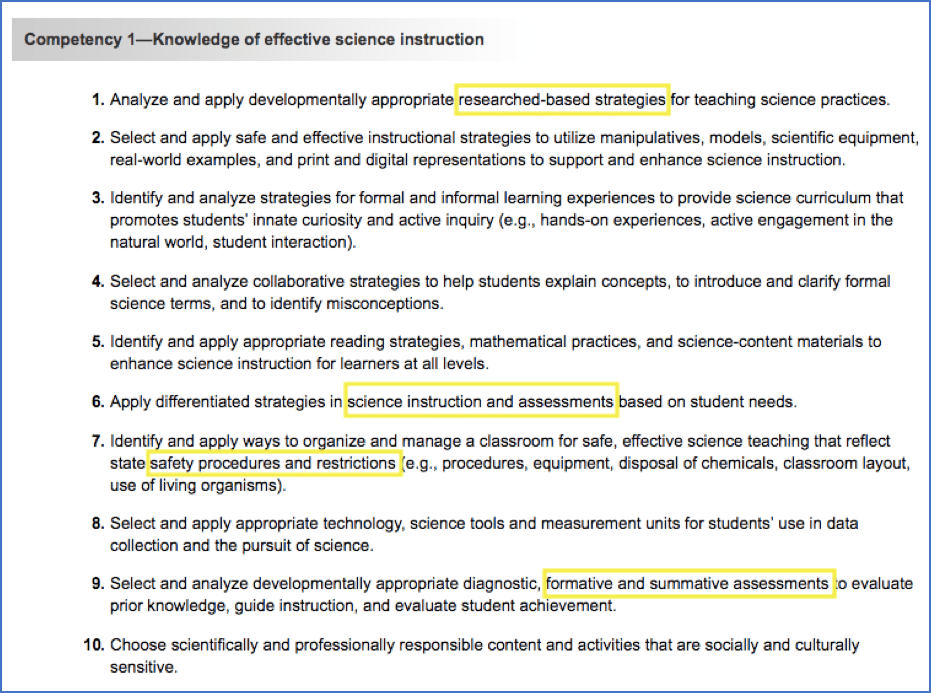
This section tests your cognition about how to teach students science concepts and skills and then assess those skills.
Scientific instruction makes upward about xx% of the Science subtest.
In that location are three big concepts to know because they will more than likely appear on the exam:
- Scientific inquiry
- Lab safe
- Scientific assessment
The first big concept to know is how to teach students the process of scientific inquiry. To learn more virtually the world, scientists use skills such as observing, predicting, classifying, inferring, and making models.
Sometimes a large set of related observations tin can be connected by a single explanation. A science teacher must sympathise and communicate the importance of scientific inquiry and the office information technology plays in solving problems effectively and in answering questions in everyday life.
In that location are inquiry-based strategies for teaching scientific inquiry.
You demand to know the scientific inquiry process, why it's of import to teach students, and how to teach information technology.
Lab condom is super important because information technology keeps everyone safe. And safe students are able to learn.
You need to know the basic lab safety requirements and common rules like:
- Never put chemicals back into the container.
- E'er habiliment goggles.
- Wash hands before and afterward experiments.
- Direct the openings of containers away from the face.
- Exercise non swallow or drink in the lab.
In that location are many more than lab safety rules. These are just a few. Take some time to research more and why they are important.
The last big concept to know is how to assess students' science skills. Yous need to assess students in a variety of ways using both formative and summative assessments. These assessments should guide future scientific discipline lessons. As the teacher, you should as well provide students with feedback on how they are doing with specific science skills.
Think about dissimilar ways to appraise students' science noesis.
So, those are the big concepts.
Specific Concepts
Allow's accept a expect at some specific concepts that could pop up on the test.
Formative versus Summative Cess
A formative assessment is the ongoing cess of a student'due south learning. The goal is to monitor student learning.
A summative assessment is the final appraisal of a student'due south achievements. The goal is to evaluate student learning.
Know the difference between the ii types of assessments and how you may use both of them for science teaching and cess.
Lab Rubber Symbols
To brand sure students are safe, there are several lab safety symbols that you, the teacher, need to know and teach students. These include symbols for:
- Safety goggles required
- Caution with potentially fragile equipment
- Gloves required
- Open flame caution
- Hand washing required
There are several more than. Do an Internet search of lab safety symbols and familiarize yourself with them.
Scientific Process
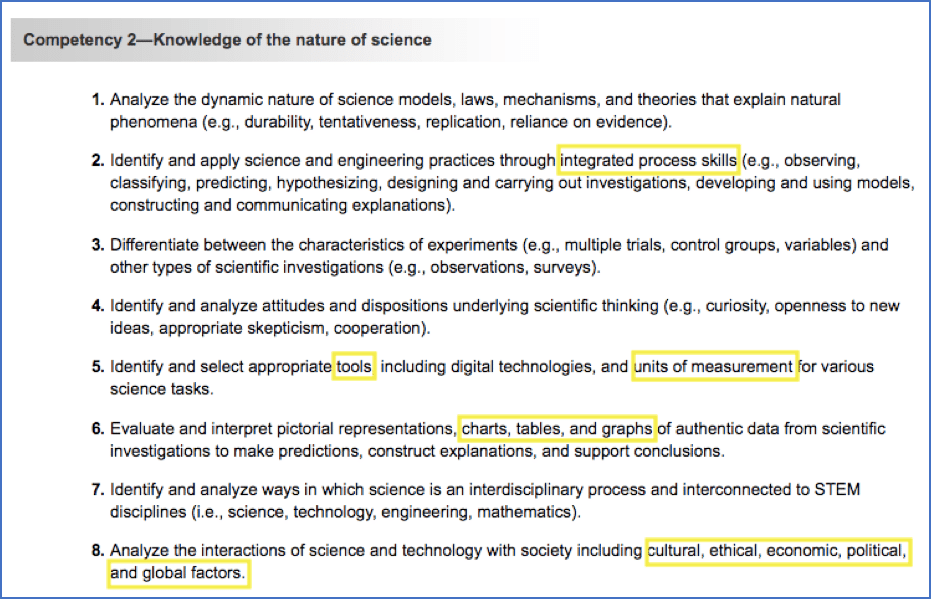
This section tests your noesis on how to provide opportunities for students to investigate the natural world through carefully planned processes.
Scientific process questions make up about xviii% of the Science subtest.
There are three big concepts to definitely know for the exam. They are:
- The scientific method
- Scientific tools
- Effects of scientific discipline
The first big concept is knowing what the scientific method is. The scientific method is a style to inquiry using steps to solve a trouble and gathering information to accomplish a decision.
The steps of the scientific method may look a little different from grade to grade, just here are the basic steps:
- Make an ascertainment
- Class a question
- Form a hypothesis
- Conduct an experiment
- Analyze the data
- Draw a conclusion
- Communicate the determination
Know the bones steps of the scientific method and what each one looks like in the classroom.
Scientific tools include the metric organization (units of measurement), data organizers (charts and graphs), digital technologies, and lab equipment.
You lot'll be using all of these to teach science.
I'll go into detail with a couple of these, but yous should know what these are and know several examples of each.
And the final large concept to know is the effects of science on civilization, ethics, the economy, politics and the world.
Think about conservation, alternative free energy sources, cloning, stem cell research, genetic testing, fitness and health, man reliance on fossil fuels, and many, many more.
Those are the big concepts to know.
Specific Concepts
Hither are some specific concepts that have a good run a risk of showing up on the exam.
Units of Measurement and Abbreviations
You need to know the units of measurement for the metric system, which is the standard organisation of measurement that nosotros use.
Commit these units to memory:
- meter: measures length
- liter: measures volume
- gram: measures mass
- second: measures fourth dimension
- newton: measure weight
Also, note these abbreviations:
- kilo: thou units
- hecto: 100 units
- deca: 10 units
- deci: one/10 unit
- centi: i/100 unit
- milli: 1/k unit
It would exist smart for y'all to do conversions inside the measurement system.
Types of Charts and Graphs
Y'all also need to know the different types of charts and graphs you will use for science pedagogy. They are:
- Data table
- Bar graph/histogram
- Line graph
- Circle graph
Know what each of these are, what they look similar, and how they brandish information.
Kinds of Lab Equipment
As a science teacher, you will need to know about the different kinds of lab equipment and how to properly use and make clean them. These tools include:
- Balances
- Beaker tongs
- Beakers
- Graduated cylinders
- Microscopes
- Burners
- Erlenmeyer flasks
- Eyewash station
These are just a few but are the most common equipment.
Concrete Science
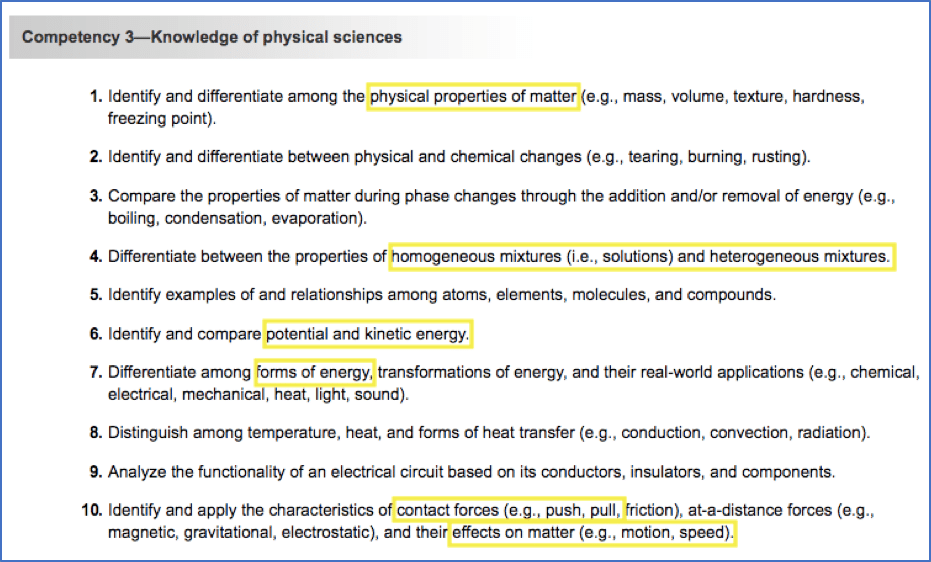
This section tests your cognition about non-living systems (recollect physics, chemistry, astronomy, etc.).
Concrete science questions make up virtually 20% of the Science subtest.
At that place are iii big concepts to know. They are:
- Force and Motion
- Physical and Chemical Backdrop
- Energy
The first big concept to know is force and movement.
Motility is the physical change in position of an object in proportion to a point of reference.
Strength is a push or pull on an object.
You should also know these terms:
- speed
- velocity
- acceleration
- momentum
- friction
- inertia
- mass
- buoyancy
- density
- work
Also, await up Newton's Laws. Yous need to know these for the exam.
Physical and chemical properties are means to classify matter. By the manner, matter is anything that has mass and takes up space.
Physical backdrop are the physical characteristics of matter or energy.
Chemic properties are the characteristics of a substance'southward reactions that change the identity of the substance.
You need to know virtually the Periodic Tabular array of Elements, the unlike types of pure substances and mixtures, what physical and chemical changes are, the states of matter and their characteristics, and the pH scale.
The last big concept to know is energy. Energy is the ability to practise work or apply a forcefulness over a distance.
Know that energy is never created or destroyed; it simply changes forms. And information technology can be transferred is a bunch of different ways.
There are two wide kinds of energy: kinetic and potential. Know what these are and the differences between them.
There are also many forms of energy like chemic, electrical, heat, calorie-free, sound, etc.
Specific Concepts
Now allow's wait at some specific physical science concepts.
Homogeneous and Heterogeneous Mixtures
In a homogeneous mixture, or a solution, all of the substances are evenly distributed (retrieve blood, air, and table salt water). All of information technology looks the same.
In a heterogeneous mixture, the substances are not evenly distributed and wait different (remember chocolate chip cookies, beach sand, and the air with clouds).
Make sure you lot know the difference between these two mixtures.
Potential and Kinetic Energy
Remember, energy is the ability to practise work or apply a forcefulness over a distance. In that location are ii broad classifications of energy.
Potential energy is stored free energy. A stone on the edge of a cliff has potential energy because gravity might pull it downwardly.
Kinetic energy is the free energy of movement. When potential free energy is used, information technology turns into kinetic energy. Then, if that rock falls downwards the side of the cliff, during its fall, information technology has kinetic energy.
Make sense? Practiced! Exist certain to know the departure between potential and kinetic energy.
Newton's Laws
Newton's beginning law, the constabulary of inertia, says that an object resists changes in its state of movement. Remember this? "An object in motion will stay in motion unless acted on by an equal or reverse force." Retrieve about why seatbelts are important.
The second law explains why objects with greater mass require more forcefulness to move the object. Strength = mass * acceleration.
Newton'southward third police force explains why objects move in the opposite direction of the greater forcefulness. "For every action, there is an equal or reverse reaction."
Take some time to expect up Newton and his laws of motion.
Earth and Space Science

This section tests what you know about the earth, its characteristics, and infinite, and its characteristics.
Earth and space scientific discipline questions make upward virtually 19% of the Science subtest.
There are 3 actually big concepts to know:
- World Systems
- Weather and Climate
- Solar System and the Universe
The first big concept to know is most earth's systems. This includes knowing the structures of world, especially geologic formations similar mountains, volcanoes, and canyons.
You should also know the four layers of earth and their characteristics.
Other things to research include the different spheres (atmosphere, geosphere, biosphere, and hydrosphere), plate tectonics, rocks and minerals, soil, and rut transfer from the dominicus.
This is a super broad concept. A study guide could actually come in handy to help ready you for the test. I know of a proficient one!
Another big concept to know includes weather and climate. The main deviation between atmospheric condition and climate is time. Conditions describes the weather over a curt period of time, while climate is the average daily weather for a long flow of time.
Some of import words to know are:
- humidity
- seasons
- air current
- temperature
- air pressure
- density
- water vapor
- barometer
- psychrometer
- anemometer
- Coriolis effect
Know what these words hateful!
And the last big concept to know involves the solar organisation and universe. Basically, you need to know what's out at that place in space (the sun, planets, asteroids, stars, comets, meteoroids, etc.) and about the lord's day-moon-earth human relationship. These systems together create tides and seasons.
Also, be enlightened of the lunar cycle and its process and stages.
Finally, brush upwardly on central events in infinite exploration and their furnishings on gild.
Those are the big concepts to know nearly world and space science.
Specific Concepts
Okay. Let's talk near some specific earth and space science concepts.
The H2o Bike
Now, the water cycle is really talking about how water goes from the body of water into the atmosphere, turns into rain, falls on state, and then is transferred dorsum to the ocean.
Yous see, the water wheel is one of the pillars of life on Earth. And so, we have to empathize it to go questions right on that Globe and Infinite Science section.
Make sure you know the stages of the water bike, what drives the water cycle, and these words:
- evaporation
- condensation
- humidity
- precipitation
- surface runoff
Characteristics of Soil
Soil germination occurs due to the weathering and erosion of rocks.
There are v components of soil:
- minerals
- organic material
- living organisms
- water and air
- nutrients
Make sure you know what is in each component.
The process of soil germination takes many hundreds (or thousands) of years. So, a really long time.
Major Events in Space Exploration
There have been a lot of advancements in space exploration. But there are really a few, big key events that have really affected order. Here are a few:
1957: The first satellite, Sputnik, is launched into space.
1961: The first man, Yury A. Gagarin, successfully orbits globe. It takes 1 hour and twenty-nine minutes.
1969: The first lunar landing, Apollo xi, makes Neil Armstrong, Edwin Aldrin, Jr., and Michael Collins household names. Recall? "That's one pocket-sized pace for human being, one giant leap for flesh."
1990: The Hubble Telescope is launched into space.
There accept been many more than happenings in space exploration, just these probably had the biggest effects on society. Read about these events and how they affected the world.
Life Scientific discipline
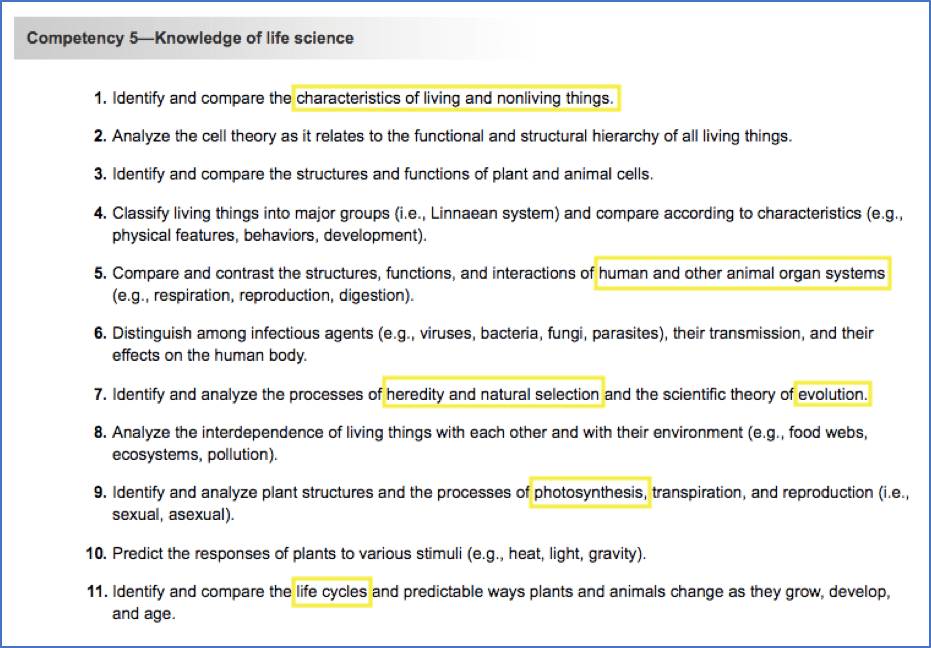
This section tests your knowledge on living things and life processes.
Life science questions make up about 23% of the Science subtest. Information technology's a big ane.
There are 3 pretty big concepts you lot need to know:
- Living Things
- Evolution and Alter
- Genetics
The kickoff big concept to know is about living things and their life cycles.
You lot need to know how organisms can exist classified. There are three big domains:
- prokaryotes
- eukaryotes
- archaebacteria
So, you can suspension those down into six kingdoms:
- animal
- plant
- fungi
- protist
- eubacteria
- archaebacteria
From there, you can continue to sort living things into categories by phylum, class, order, family, genus, and species. This ranking is called the taxonomic hierarchy. Be sure to know what all of these words mean.
Yous too demand to know what a cell is, both plant and animal, and what parts make up a prison cell.
Finally, make certain you know the human being body systems, parts of a institute, the life cycles of animals and plants, and how both animals and plants reproduce.
In that location is and so much information to know hither. A thorough study guide would be an excellent resource to utilise.
Another big concept to know is virtually evolution and change. Living and non-living things in an environment are partners in keeping an ecosystem in balance. Living things constantly interact with their environment. Organisms can modify in response to environmental conditions, and the surround tin change in response to a population or group of organisms.
Brand sure you tin define these terms:
- development
- adaptation
- population
- extinction
- natural selection
- selective breeding
- mutation
Finally, the final big concept to know is about genetics. Genetics is the study of traits passed down from parents to offspring.
At that place are several terms to know:
- traits
- heredity
- sperm
- egg
- allele
- gamete
- meiosis
- mitosis
- genotype
- phenotype
- ascendant
- recessive
Too, know what Dna and RNA is and how they are different.
So, those are the large (very big) concepts to know.
Specific Concepts
Here are some specific life scientific discipline concepts that are likely to appear on the test.
Living versus Not-living Things
There are seven characteristics of living things:
- use energy
- motility
- breathing
- get rid of waste
- grow and develop
- reply to environment
- reproduce
Some non-living things may have a couple of these characteristics, but a living thing volition have all of them.
Be certain to know these characteristics and what they mean.
Human Body Systems
Yous also demand to know the different systems within the human body. They include:
- circulatory
- digestive
- endocrine
- integumentary
- lymphatic
- muscular
- nervous
- renal
- reproductive
- respiratory
- skeletal
Accept some time to enquiry these systems and notice out what they are, what they do, and be able to compare them to other animate being's organ systems.
Photosynthesis
Photosynthesis is the process plants utilise to convert light energy into chemic energy. In simpler terms, it is how plants utilize the sunday to make food for themselves.
Exist sure to empathise this process.
And that's some very basic info about the Science subtest of the FTCE Elementary Didactics G-6 test.
FTCE Elementary Education One thousand-6 Mathematics
Overview
You will have lxx minutes to complete fifty multiple-selection questions.
The FTCE Elementary Education K-half dozen Mathematics subtest can be neatly divided into five different sections. Those five sections are:
Student Thinking and Instructional Practices
- Educatee Thinking and Instructional Practices
- Number Concepts, Operations, and Algebraic Thinking
- Fractions, Ratios, and Integers
- Measurement, Data, and Statistics
- Geometry
You will be given a Mathematics Reference Canvas to use on the test. Click here to come across what'south on it.
So, let'southward start with student thinking and instructional practices.
Student Thinking and Instructional Practices
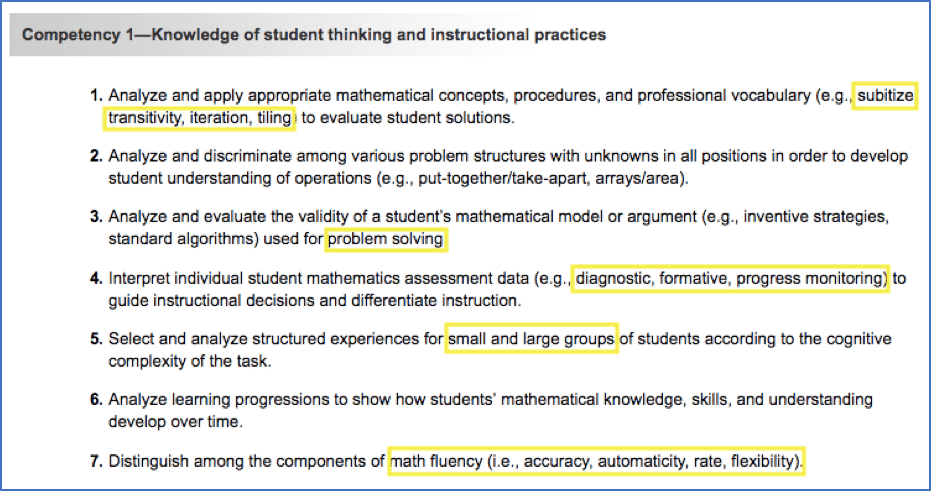
This section tests your knowledge on how students think about math and how y'all, the teacher, should teach math (aka "best practices").
Pupil thinking and instructional practices questions brand up well-nigh 26% of the Mathematics subtest.
At that place are 3 pretty big concepts to know:
- Major Theories of Learning
- Teaching Strategies
- Assessment
The showtime big concept to know is the major theories of learning and how they can be applied to math. First of all, there are a lot of theories about how children learn. But here are some important ones to read and recall about:
- Behaviorism
- Constructivism
- Social Learning
- Sociocultural Learning
More specifically, have a expect at these theories:
- Piaget'due south Iv Stages of Cerebral Evolution
- Bloom's Taxonomy
- Levels of Geometric Thinking (van Hieles)
Be sure to know what each of these are and how they tin be applied to math.
You lot should too read over Florida's standards for each form level. You can do that by clicking here.
The next big concept is teaching strategies. Remember, as I've said a few times before at present, there are "best practices" for pedagogy each subject area.
Take a look at this publication past National Council of Teachers of Mathematics (NCTM). They outline some constructive teaching practices for math.
As well, exist sure to know what manipulatives are, why they are important to use, and exist aware of some specific manipulatives like geoboards, design blocks, number lines, base ten blocks, tangrams, etc.
You besides need to know the importance of using small groups to differentiate math instruction.
Finally, the last big concept to know is how to assess students' knowledge in math. Know these types of assessments and when to use them:
- diagnostic
- formative
- progress monitoring
Recall, assessments should guide your planning and instruction and assistance you differentiate for each student.
So, those are the big concepts to know concerning educatee thinking and instructional practices.
Specific Concepts
Allow'due south take a look at some pretty specific concepts that are likely to appear on the exam.
Trouble-Solving Construction
Trouble-solving is a disquisitional skill that students need to master in all subjects, including math. Let's accept a look at a item problem-solving model called Polya's Model. Here are his iv steps to problem-solving:
- Sympathize the problem
- Devise a program
- Acquit out the plan
- Review/confirm/extend
Now, there are a lot of problem-solving methods out there, simply all of them are basically some form of Polya's original iv steps. And there are several strategies yous can use to devise a plan (Step 2) like working astern and using a formula.
Exist sure you are able to apply the four steps to solve a math problem.
Math Fluency
You really demand to know the different components of math fluency and why it's important for your students to be fluent in math. The components of math fluency are:
- accurateness
- automaticity
- rate
- flexibility
These components are a little bit unlike than reading fluency.
Accurateness means solving bug with the best method, the right steps, and in the right order to get the correct answer.
Automaticity means knowing the answer to a problem right away. Y'all've washed it so many times that its virtually just an instant reflex. An example is knowing right away that 10 10 three = thirty.
Rate is all about being efficient. Y'all tin can complete the steps of trouble-solving chop-chop. Y'all know exactly what pace to take side by side and don't waste matter time being "lost".
Finally, flexibility means that you lot are comfy using more than one approach to solve a trouble. Yous sympathize numbers and operations well, then yous tin can manipulate the information and remember critically. If you don't know the answer right away, you lot know a way to figure it out.
Professional Vocabulary
These are some words yous need to know. How do I know? Because they appear correct in the description of the skill that you will exist tested on. Information technology's like the state is handing you a little gift. Take advantage of this souvenir and learn these words!
Subitizing is a style of instantly counting (instance: yous see a group of dots and know immediately that in that location are x, without counting).
Transitivity. Okay. Stay with me here. Recollect of three elements. We volition call them A, B, and C. Transitivity means that if A is related to B, and B is related to C, and then A and C must also be related to each other. Get it?
Iteration is when y'all repeatedly solve a problem using a effect from a previous problem.
Tiling is when y'all put individual tiles together with no gaps or overlaps.
Number Concepts, Operations, and Algebraic Thinking
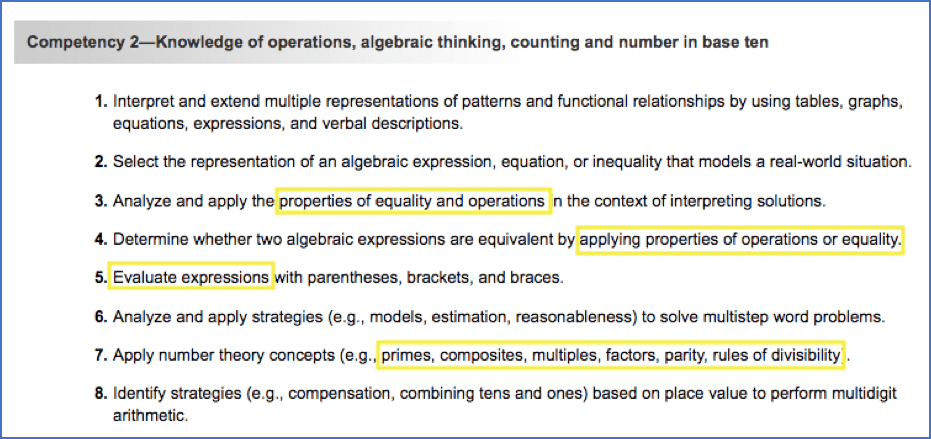
This section tests what you know near numbers, if you can dispense those numbers, and how well you can do algebra.
Number concepts, operations, and algebraic thinking questions make upwards about 28% of the Mathematics subtest.
Here are some specific concepts to know.
Properties of Math
Think of a property as kind of like a rule you need to follow. Okay? There are quite a few of these properties.
- Commutative Property of Addition
- Commutative Property of Multiplication
- Associative Property of Addition
- Associative Property of Multiplication
- Distributive Property
- Additive Identity Property
- Condiment Inverse Property
- Multiplicative Identity Property
- Multiplicative Inverse Belongings
Whew. Like I said, in that location's a lot. You need to know what these are and how to solve problems using them. A really thorough report guide would be a great resources to take and use.
Solving for x
Solving for x is pretty straightforward. The exam will give you an equation and then y'all have to solve for ten. And then, the test volition give you an equation like:
4×2– iv(3 + 2) = 16
And in this equation, nosotros would merely demand to rest the equation for x, and so you would simplify it as much as you tin can, residue the equation, and you lot'd notice that x equals 3.
4×2 – 4(5) = xvi
4×2 – 20 = 16
4×2= 36
x2= 9
ten = three
Order of Operations
The club of operations, or PEMDAS, P-E-MD-Equally, is merely the process you follow to simplify and piece of work an equation.
Let me give you an instance. If you lot have an equation like this:
2(x – 3) + 3(x + 4)2
You have to work the problem according to a specific order, the order of operations.
In this particular example, you would first solve for the parentheses, and then you lot would solve for the exponents. Then going left to right, you practice either multiplication or division and so y'all would add or subtract in the same club (from left to right).
So that's why we group the Grand and the D and the A and the Southward together.
Now, this is incredibly important because, on the test, you will be required to simplify an equation. So, you have to know the order of operations to get that question correct.
Number Theory Concepts
You lot need to know what these words mean and how to apply them to solve issues:
- prime number
- composite
- parity
- multiples
- factors
- rules of divisibility
So, these are just a few concepts that will appear in this department of the subtest.
Fractions, Ratios, and Integers

This section tests your power to solve word problems and equations with fractions, ratios, and integers. You volition also have to compare fractions and integers and place them on a number line.
Fractions, ratios, and integers questions make up 18% of the Mathematics subtest.
Let's talk nigh some specific concepts that will for certain exist on the test.
Value of Integers
You demand to know the value of specific, and sometimes irregular, integers.
Now, the test volition, and I mean will, accept you identify different forms of numbers from greatest to least or least to greatest. Sometimes you'll place those numbers on a number line.
In a given data set, you might take two fractions, a decimal, the number pi, a negative integer, and a regular integer and you must organize all these from least to greatest.
And then, make sure you know how to translate decimals to fractions and fractions to decimals, so you lot can compare the two and effigy out which 1 is greater or less.
Oh, and besides make sure you empathise decimals to the hundredths place.
Fraction Operations
On the examination, yous will be asked to add, subtract, multiply, and divide fractions, including mixed whole numbers and fractions. You also need to know these words:
- reciprocal (multiplicative changed)
- mixed whole number
- simplify
- numerator
- denominator
Word Problems
Now, the final major concept to know is how to read, structure, and utilise mathematical word bug, particularly those containing fractions and ratios.
At present, my biggest tip to aid you in this is just to work through a lot of authentic practice questions, specifically, give-and-take bug in mathematics.
Now, while these questions aren't going to be the most complex, it does take a lot of practise to learn how to read a question prompt, understand the mathematical question the prompt is conveying or asking, and then taking that and boiling it downward and then yous can solve for it.
And actually, it's simply one of those things you have to practice, practice, practice. And so, notice a neat source of authentic exercise questions that you can use.
Measurement, Data, and Statistics
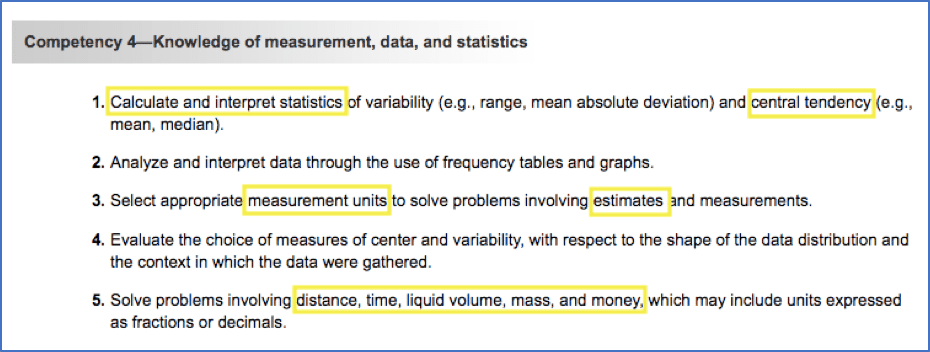
This section involves analyzing sets of data, using measurement units to solve problems, and calculating and interpreting statistics.
Measurement, data, and statistics questions make upwards near 16% of the Mathematics subtest.
Here are some concepts that are more than than likely to appear on the exam.
Central Tendency Measurements
So, what'southward about guaranteed to evidence up on the exam? Central tendency measurements. What'southward cardinal trend measurement?
Information technology's simply 4 concepts: mode, median, mean, and range.
Now, on the test, they're going to give y'all a data set of well-nigh 8 to 12 numbers, and they're going to inquire you lot one or more of the post-obit. What is the style? What is the median? What is the mean? Or what is the range of the data set up?
So, y'all have to know what those central tendency measurements are and how to find them for a data gear up. And when you exercise, piece of work on a data ready of about 8 to 12 double-digit numbers.
Measurement Units
You lot're going to demand to know basic measurement concepts.
The beginning is how to estimate or approximate. It's pretty straightforward.
The second is just to be familiar with different units of measurement. Units similar temperature, time, money, mass, weight, book, speed, and percentages.
At present, merely like with word problems and number concepts, this mathematical concept isn't necessarily complex, you lot just demand to make sure you're familiar with those dissimilar types of measuring units.
Interpret Statistical Models
And the final major concept is how to translate different statistical models.
And actually, it's specifically regarding either standard deviation or quartiles.
Many times, when I've seen a question like this, the test will provide some sort of data most a set of students' scores.
Yous volition then have to extrapolate based on that data and the concepts of either quartiles or standard deviation.
Geometry
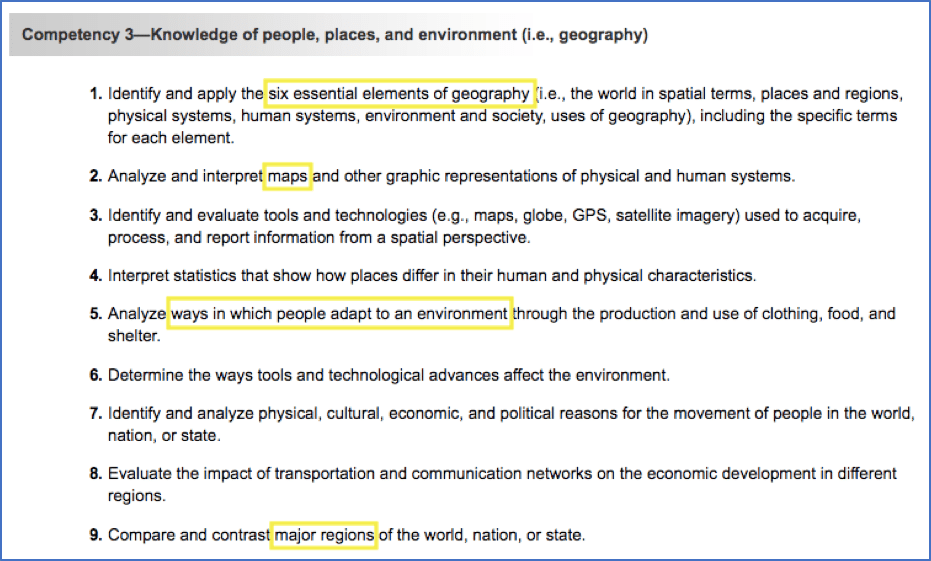
This department tests your cognition on both 2nd and 3D shapes and your ability to solve problems concerning perimeter, expanse, surface expanse, and volume.
Geometry questions make up about 12% of the Mathematics subtest, and then it'southward the smallest section, but don't underestimate information technology.
Let's talk about some concepts that you'll encounter on the examination.
Pythagorean Theorem
The Pythagorean Theorem is used to find any length of a side of a right triangle (if you know the other two sides).
The equation of the Pythagorean Theorem is:
a^2 + b^2= c^two
Where A and B are the two sides of the right triangle and C is the hypotenuse of the triangle.
If yous have anything from this, take this one thing: you will have a question about the Pythagorean Theorem on the test. That is an absolute guarantee. It volition most likely exist in some sort of word problem.
An example would be:
Billy walked three blocks west, and 4 blocks due north. If Billy walked a straight line, how many blocks would Billy have walked?
Something like that will show up on the exam.
Types and Characteristics of Triangles
And while nosotros're talking almost triangles, before yous take the test, brand sure y'all know the unlike kinds of triangles and their backdrop.
Now, the different kinds of triangles yous most need to be familiar with would be:
- right triangles
- isosceles triangles
- equilateral triangles
- scalene triangles
Now, a lot of the differences between the triangles are actually going to come up down to the differences of interior angles within the triangle.
So, while you're studying the unlike characteristics of triangles, make sure you understand the dissimilar characteristics of the interior angles of the triangles.
Three Dimensional Shapes
You likewise need to know how to identify the properties of iii-dimensional shapes (sphere, cube, rectangular prism, cone, cylinder, pyramid, etc.). These properties include:
- book
- faces
- edges
- vertices
Know what each of these are and how to identify them. Each three-dimensional shape has a formula for figuring out volume.
And that'due south some basic information about the Mathematics subtest of the FTCE Elementary Education K-vi exam.
Source: https://www.240tutoring.com/ftce-prep/elementary-education-k-6-practice-test/
0 Response to "Mcdougal Littell Preparing for the Istep Language Arts Test Elementary School"
Post a Comment